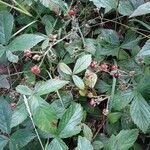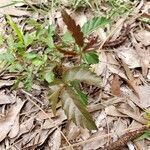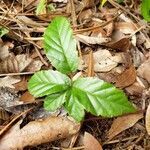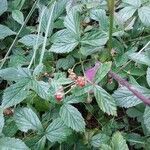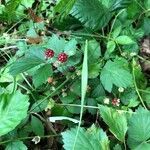Low-growing scrambling shrub; primocanes spreading (but fruiting stems often ± prostrate), purplish or red, usually ± terete, sometimes somewhat angled and ± flat between, with scattered subsessile glands, otherwise sparsely clothed in only simple hairs or almost glabrous; armature of many, short, erect prickles on angles or scattered. Young shoots moderately clothed in simple hairs and glandular. Leaflets (3)-5, almost glabrous to sparsely pilose on upper surface, sparsely to moderately pilose on veins but not tomentose on lower surface, irregularly serrate-dentate; terminal leaflet lamina narrow-to broad-ovate, acuminate, 40-100 × 40-90 mm, with petiolule c. ⅖-3/5 length of lamina. Stipules linear to broadly lanceolate. Infl. sparsely to moderately hairy, with sessile glands. Sepals rounded and apiculate to acuminate, sparsely to moderately pilose but tomentose only on margins and within, without pricklets. Petals rounded, crinkled, white. Anthers glabrous.
Primocanes prostrate or low-arched, normally rooting at least at the tip, never bristly, ± armed with small, stout, curved, somewhat hooked prickles with expanded base; foliage and pubescence various, but lfls of the compound floricane lvs regularly of an ovate type, and sharply acute or acuminate, broadly rounded to the base or even subcordate, widest distinctly below the middle; fls occasionally solitary and terminal, more often 2–5, each pedicel, except possibly that of one of the two terminal fls, subtended by a 3-foliolate lf or by a simple lf with expanded blade, the pedicels elongate and suberect. Often in pockets of soil on ledges and cliffs, as well as in disturbed habitats. Chiefly northern, from e. Can. to Minn., but extending s. to Ga. and Ark. May, June. (R. baileyanus; R. curtipes; R. foliaceus; R. invisus; R. jaysmithii; R. maltei; R. meracus; R. occidualis; R. plexus; R. profusiflorus; R. redundans; R. roribaccus; R. temerarius)
A trailing plant. It grows 20 cm tall and spreads 2-5 m long. The old stems are woody and have hooked prickles. The leaves are alternate and compound. They have 3 leaflets. The leaflets are 8 cm long by 3 cm wide. They have double teeth along the edge. There are 1-5 flowers at the ends of the stems. The flowers are white. The fruit is compound and fleshy. They can be 2.5 cm long. They turn purple to black when ripe.
Prostrate shrublet. Leaves 3-5-foliolate, leaflets ovate, 35-70 x 25-50 mm. Corolla longer than calyx. Flowers white. Fruits black, adhering to torus.
